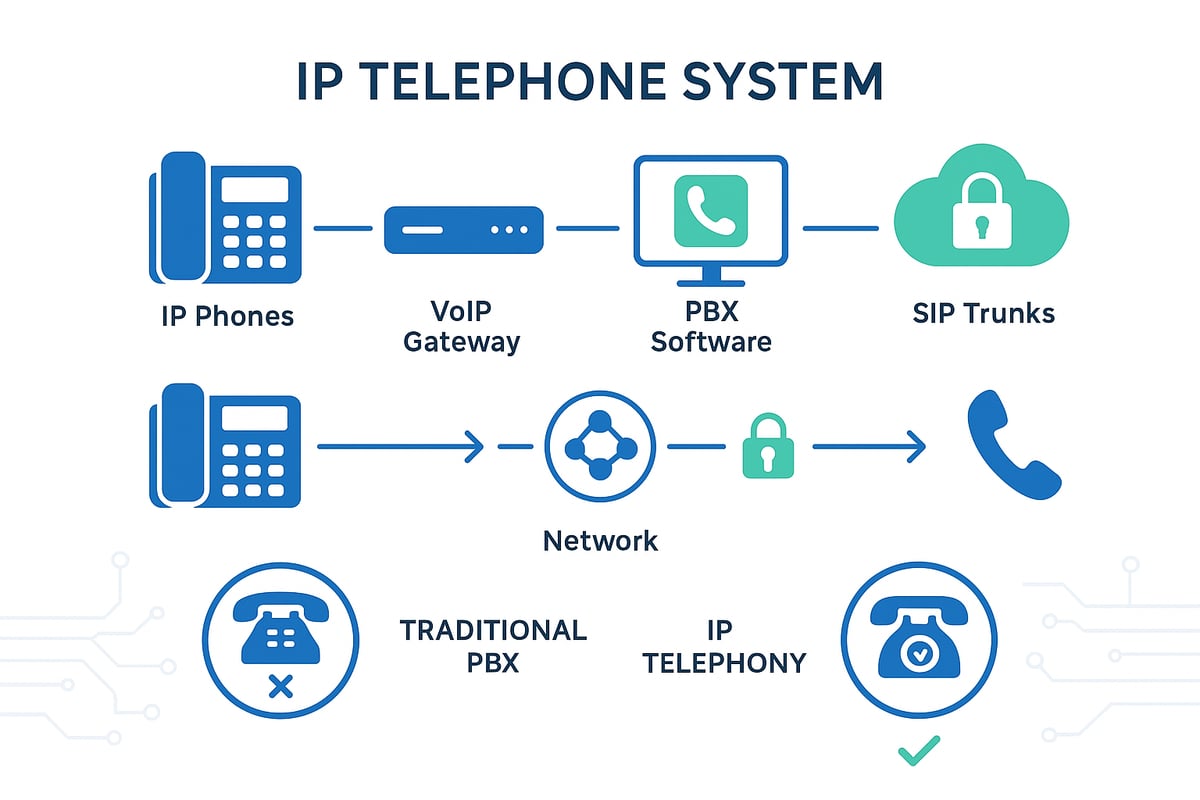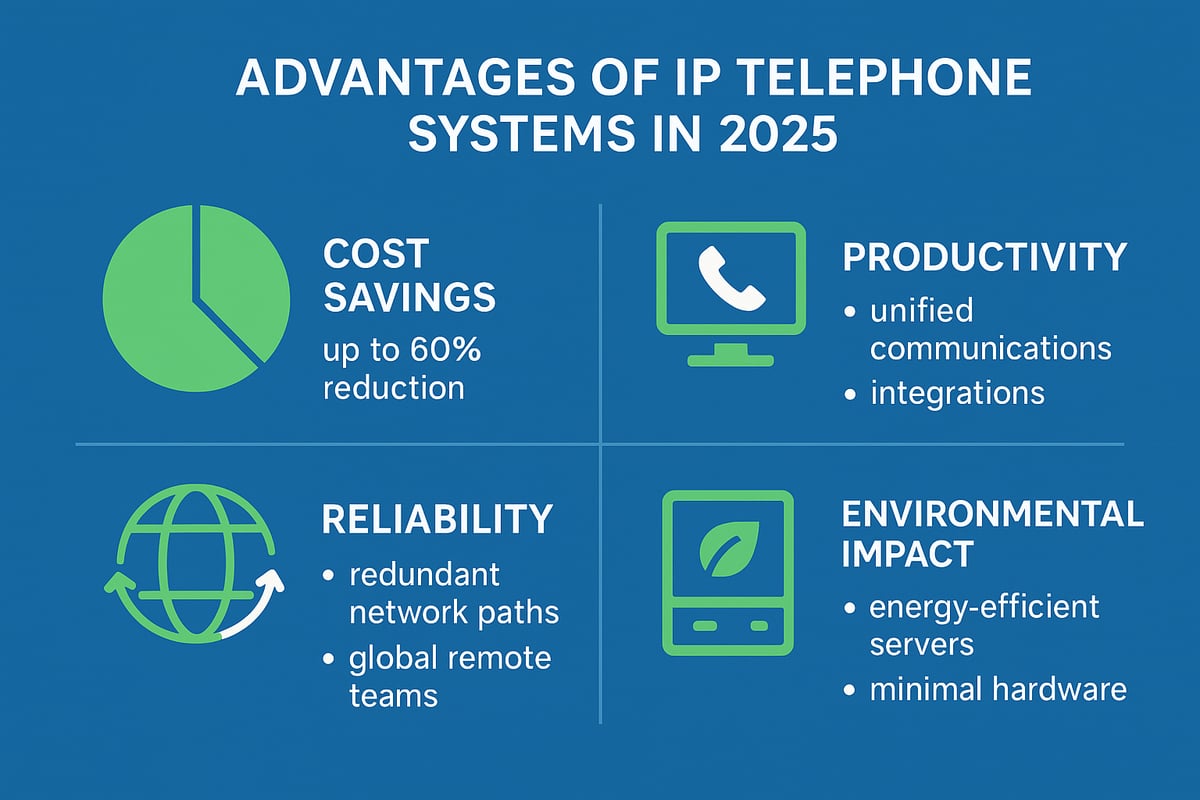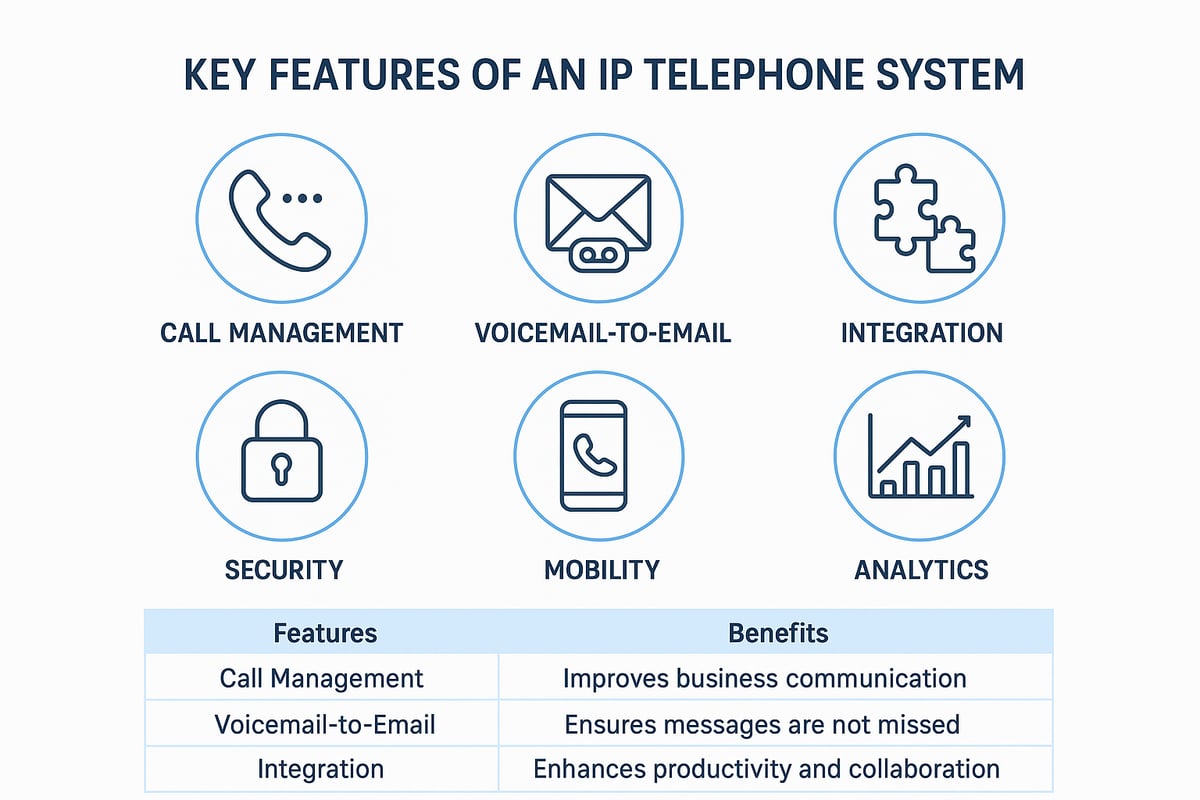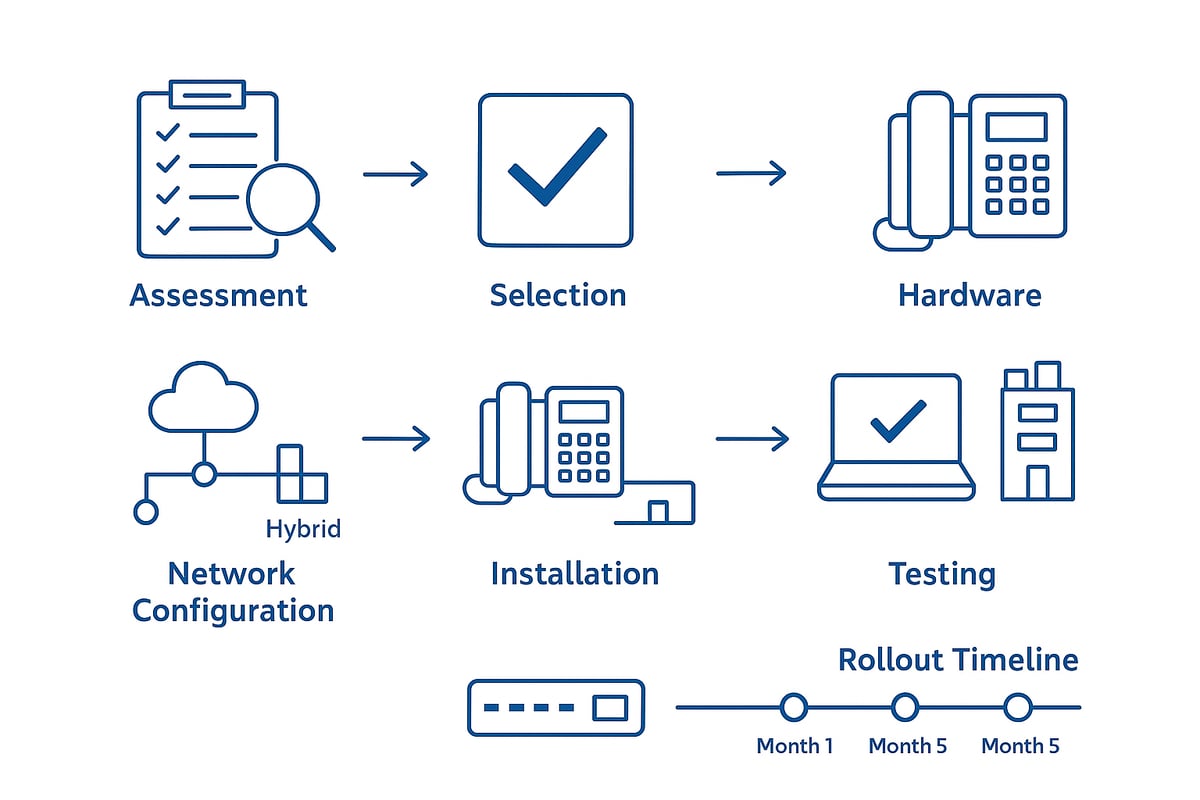IP Telephone System Guide: Everything You Need to Know in 2025
Unlock the power of IP telephone system solutions in 2025 with this comprehensive guide covering features, setup, cost, and future trends for your business success.
Redaction
10/10/2025, 12:30:00Imagine transforming your business communications with an ip telephone system in 2025. This comprehensive guide will help you navigate everything you need to know, from core concepts to advanced features. Discover how an ip telephone system can streamline operations, reduce costs, and empower remote teams. You will learn how to choose the right solution, integrate it with your tools, estimate costs, and stay ahead with the latest innovations. Get ready to unlock the full potential of modern business communication with our step-by-step approach.
What is an IP Telephone System?
An ip telephone system is transforming the way organizations communicate in 2025. Unlike traditional phone setups, these systems operate using digital networks, offering flexibility and advanced features that analog lines cannot match. Understanding how these systems work is crucial for businesses aiming to stay connected, efficient, and future-ready.

Definition and Core Concepts
An ip telephone system is a modern communications platform that uses Voice over Internet Protocol (VoIP) to transmit voice calls over data networks. This approach replaces traditional PBX and analog systems, which rely on copper wiring. The core difference is that, instead of circuit-switched calls, voice data is converted into digital packets and sent through local area networks (LAN) or the internet.
The foundation of every ip telephone system is VoIP technology. Key components include IP phones (hardware or software-based), VoIP gateways (for connecting legacy devices), PBX software (which manages call routing and features), and SIP trunks (virtual phone lines connecting to external networks). With this setup, businesses can manage calls, messages, and collaboration tools on a unified platform.
| Traditional PBX | IP Telephone System |
|---|---|
| Analog signals | Digital packets |
| Copper wiring | Data networks |
| Limited features | Advanced features |
For a deeper dive into the PBX component, see What Is a VoIP PBX System.
In 2025, common business solutions include Allworx, Avaya, and Grandstream, each offering scalable and feature-rich ip telephone system options.
How IP Telephone Systems Work
When a user initiates a call on an ip telephone system, the device digitizes the voice and breaks it into small packets. These packets travel over the company’s LAN or the internet, using standard network protocols. The system’s PBX software determines the call route, connects to the recipient, and reassembles the voice for real-time conversation.
A simplified call flow:
- User dials a number on their IP phone.
- Voice is encoded into data packets.
- Packets travel through routers and switches.
- PBX software manages call routing.
- The call reaches the destination, where packets are decoded back into audio.
The ip telephone system relies on robust internet connectivity and seamless integration with existing IT infrastructure. Security is a top priority, with protocols like Secure SIP and data encryption protecting sensitive business communications from interception or unauthorized access.
Types of IP Telephone Systems
Businesses can choose from several ip telephone system types, depending on size, budget, and existing equipment. The main models are:
- On-premises IP PBX: Hardware and software are hosted at the business site, offering full control and customization.
- Hosted/cloud-based: The provider manages all infrastructure in the cloud, ideal for scalability and minimal maintenance.
- Hybrid systems: Combine on-premises and cloud features, allowing integration with legacy hardware.
| Type | Control Level | Maintenance | Scalability | Example Vendors |
|---|---|---|---|---|
| On-premises IP PBX | High | Internal | Moderate | Avaya, Allworx |
| Hosted/Cloud-Based | Provider | Provider | High | Grandstream, Avaya |
| Hybrid | Mixed | Shared | Flexible | Allworx, Grandstream |
Use cases vary: small businesses may opt for cloud-based systems for cost savings, while enterprises might prefer hybrid setups for integration flexibility. Remote teams, now common in 2025, benefit most from hosted ip telephone system solutions that support global connectivity and mobile access.
Advantages of IP Telephone Systems in 2025
Businesses in 2025 are reaping significant rewards from adopting an ip telephone system. From reducing monthly expenses to unlocking advanced features, the benefits are both immediate and far-reaching. Below, we break down the primary advantages that make an ip telephone system an essential asset for modern organizations.

Cost Savings and Scalability
Switching to an ip telephone system can drastically reduce operational costs. Unlike traditional phone lines, VoIP-based solutions eliminate long-distance and international call fees. Many businesses report saving up to 60% on their monthly communications budget after transitioning.
Flexible pricing models are another advantage. Companies can start with a modest setup and scale as their workforce grows, only paying for what they use. This pay-as-you-grow model is particularly attractive for startups and expanding enterprises.
For a deeper dive into leading solutions that maximize these savings, see the Best VoIP Solutions for Business, which outlines top providers and cost structures.
| Cost Factor | Traditional PBX | IP Telephone System |
|---|---|---|
| Setup Fees | High | Low |
| Maintenance | Ongoing | Minimal |
| Call Charges | Per Minute | Often Included |
| Scalability | Limited | Flexible |
Enhanced Features and Productivity
An ip telephone system offers unified communications features that boost team productivity. Employees benefit from voicemail-to-email, call forwarding, and mobile app integration, allowing seamless communication regardless of location.
Integration with productivity platforms, such as Microsoft Teams or Slack, streamlines workflows and centralizes communication channels. Advanced analytics provide actionable insights, helping managers optimize staffing and customer service. Many firms have improved customer satisfaction by implementing intelligent call routing and IVR, ensuring callers reach the right department quickly.
Reliability and Flexibility
Reliability is a cornerstone of the modern ip telephone system. With options for redundancy and automatic failover, businesses minimize downtime during outages or disruptions. Secure, encrypted communications protect sensitive information, providing peace of mind for IT teams.
Flexibility is equally important. The ip telephone system enables remote work, supporting global teams and hybrid work models. In 2025, over 80% of organizations rely on ip telephone system platforms to connect employees in multiple locations, making business continuity a given.
Environmental and Maintenance Benefits
Adopting an ip telephone system reduces hardware requirements and energy consumption. By leveraging cloud-based solutions, companies can operate with minimal onsite equipment, lowering their carbon footprint.
Maintenance is more straightforward with software-based management. Updates and troubleshooting can be handled remotely, reducing the need for physical service calls. These environmental and operational benefits align with corporate sustainability goals and modern IT best practices.
Key Features to Look for in an IP Telephone System
Choosing the right ip telephone system means understanding which features will drive the most value for your business. The landscape is evolving rapidly, and selecting a system with the right tools ensures your communication infrastructure is prepared for growth, security, and productivity.

Essential Communication Features
A modern ip telephone system provides a comprehensive suite of features that go well beyond basic calling. Businesses should look for:
- Call management: Transfer, hold, conferencing, and call recording
- Voicemail-to-email: Access messages anywhere, anytime
- Auto-attendant and IVR: Route calls efficiently and present a professional image
- Call queuing and hunt groups: Handle high call volumes with ease
Many leading solutions, such as those detailed in the Cisco VoIP Phone System Overview, offer intuitive interfaces and powerful call-handling tools. With these features, your ip telephone system can streamline communications and support both in-office and remote teams.
Integration Capabilities
Integration is critical for maximizing the ROI of your ip telephone system. A robust platform should connect seamlessly with:
- CRM systems for tracking customer interactions
- Helpdesk and ticketing tools to improve support workflows
- Business applications such as email, calendars, and project management suites
Look for open API access, which allows custom workflows and automation tailored to your operations. This flexibility ensures the ip telephone system enhances existing processes, rather than creating silos.
Security and Compliance
Security is non-negotiable for any ip telephone system. End-to-end encryption, secure SIP protocols, and strong authentication are essential to protect sensitive conversations.
Compliance with industry regulations like GDPR, HIPAA, or PCI DSS must also be supported. Leading systems provide audit trails, access controls, and regular security updates, reducing the risk of breaches or data leaks.
Mobility and Remote Access
Remote work is now standard practice, so your ip telephone system should offer full mobility. Key features include:
- Mobile and desktop softphone apps for staying connected on any device
- Support for BYOD (Bring Your Own Device) policies
- Seamless handoff between desk phones and mobile devices
Teams can use ip telephone system tools interchangeably across platforms, ensuring consistent communication regardless of location.
Analytics and Reporting
Data-driven decision-making is a hallmark of effective organizations. An advanced ip telephone system delivers:
- Real-time call statistics and historical reports
- Quality of Service (QoS) monitoring to identify and resolve issues
- Actionable insights to optimize staffing and customer experience
For example, supervisors can use analytics to monitor call volumes and adjust schedules, ensuring the ip telephone system directly supports business goals.
Step-by-Step Guide: How to Set Up an IP Telephone System
Setting up an ip telephone system requires careful planning and execution. This step-by-step guide walks you through the critical stages, ensuring your deployment is smooth, secure, and future-ready.

Step 1: Assess Business Needs and Network Readiness
The first step in deploying an ip telephone system is to evaluate your organization’s communication requirements. Start by inventorying existing phone usage, including call volume, features needed, and pain points.
Next, review your current internet bandwidth and internal network infrastructure. Reliable connectivity is essential for supporting voice calls and maintaining quality.
- Identify the number of users and physical locations.
- Analyze remote work expectations.
- Determine if existing hardware can be integrated with the new ip telephone system.
This assessment forms the foundation for a smooth transition and helps avoid costly surprises later.
Step 2: Choose the Right IP Telephone System Type
Selecting the optimal ip telephone system involves comparing deployment models. You can choose from on-premises, cloud-based, or hybrid solutions.
- On-premises systems offer total control, but require more maintenance.
- Cloud-based systems provide scalability, minimal onsite hardware, and remote access.
- Hybrid models let you leverage existing legacy equipment while gaining modern features.
For businesses exploring the flexibility of hosted and cloud-based options, the Hosted Voice and Cloud VoIP guide offers valuable insights into these solutions. Always consider your growth plans, integration needs, and support expectations when making your choice.
Step 3: Select Compatible Hardware and Software
Once you have chosen your ip telephone system type, select the right hardware and software components. Essential elements include:
- IP phones for staff and common areas.
- VoIP gateways to connect legacy devices if necessary.
- Network equipment like routers and switches optimized for voice.
- PBX management software and user-friendly apps.
Compatibility is crucial. Ensure your system supports the required features and works seamlessly with your existing IT environment.
Step 4: Plan and Configure Network Settings
A robust network is vital for a high-performing ip telephone system. Start by segmenting voice traffic using VLANs to reduce interference with data.
- Set up Quality of Service (QoS) to prioritize voice packets.
- Configure firewalls and NAT to allow secure SIP traffic.
- Implement encryption protocols and VPNs for remote access.
Proper configuration minimizes latency, improves call clarity, and protects sensitive communications.
Step 5: Install and Provision Devices
Now it’s time to physically deploy the ip telephone system hardware. Install IP phones at each workstation and connect them to the network.
- Use automated provisioning tools for quick setup.
- Update device firmware to the latest versions.
- Provide staff with user guides and conduct training sessions.
This stage ensures all users are equipped and ready to leverage the full potential of your new communication platform.
Step 6: Test, Optimize, and Go Live
Before launching your ip telephone system company-wide, conduct thorough testing. Make internal and external test calls to check call quality.
- Monitor network performance for bottlenecks.
- Troubleshoot any hardware or configuration issues.
- Collect user feedback to identify areas for improvement.
After resolving issues, roll out the system to all departments, ensuring support is available for a smooth transition.
Example Rollout Timeline
Efficient deployment of an ip telephone system depends on business size. Here’s a typical timeline:
| Activity | SMB Timeline | Enterprise Timeline |
|---|---|---|
| Assessment & Planning | 1 week | 2-3 weeks |
| Vendor Selection | 1 week | 2 weeks |
| Hardware Procurement | 1 week | 2-3 weeks |
| Installation & Training | 1 week | 2 weeks |
| Testing & Optimization | 1 week | 2 weeks |
| Full Go-Live | 1 day | 1 week |
Best practices include staggered rollouts, dedicated training sessions, and ongoing monitoring. By following this timeline, your ip telephone system deployment remains organized and efficient.
Cost Considerations and ROI of IP Telephone Systems
Navigating the costs and returns of an ip telephone system is crucial for any business aiming to modernize communications. Understanding expenses and potential savings helps organizations make informed, strategic decisions. Let us break down the key financial factors, practical tips, and future outlook for maximizing value.
Upfront vs. Ongoing Costs
When considering an ip telephone system, businesses face two primary cost categories: upfront and ongoing. Upfront costs often cover hardware such as IP phones, network equipment, and installation services. Ongoing costs include software licenses, subscription fees for cloud-based solutions, and routine maintenance.
| Cost Type | Examples | Frequency |
|---|---|---|
| Upfront | Hardware, setup, training | One-time |
| Ongoing | Subscriptions, support, updates | Monthly/Yearly |
Choosing between on-premises and cloud solutions can shift the balance between upfront and recurring expenses. Cloud-based ip telephone system deployments typically lower initial investments but may have higher long-term subscription costs. Evaluating these categories early ensures a realistic budget and avoids surprises down the line.
ROI Analysis
A major advantage of upgrading to an ip telephone system is its potential for rapid return on investment. Businesses often see immediate savings by eliminating expensive legacy infrastructure and reducing call charges, especially for long-distance and international communications. Advanced features, such as unified messaging and automated call routing, drive workforce efficiency and customer satisfaction.
Case studies show organizations reducing total cost of ownership by up to 50%. According to the IP Telephony Market Forecast 2025-2032, this trend is expected to accelerate as more enterprises adopt flexible, scalable solutions. Calculating ROI should factor in not just cost savings but also productivity gains and improved business agility.
Budgeting Tips
Planning your ip telephone system budget requires a clear understanding of all cost elements. Start by estimating total cost of ownership, including hardware, software, subscriptions, and support. Watch for hidden fees such as licensing, premium features, or upgrade charges.
- Compare vendor pricing models and contract terms
- Leverage bundled packages for discounts
- Schedule regular reviews to align features with business needs
Take advantage of vendor promotions, especially when migrating from legacy systems. A thorough budgeting process ensures that your ip telephone system delivers optimal value for your investment.
Scalability and Future-Proofing
The scalability of an ip telephone system is a key factor in long-term cost control. Modern solutions allow businesses to add or remove users and features as needs evolve, supporting both growth and contraction. Investing in systems that support emerging technologies, such as AI-driven automation and advanced analytics, ensures you remain competitive.
Future-proofing your ip telephone system also means considering market trends. Insights from the IP Telephony Market Analysis 2025-2033 highlight increasing adoption rates and innovation in the sector. By choosing a solution designed for flexibility and integration, your business can adapt to new opportunities while controlling costs.
Future Trends and Innovations in IP Telephone Systems
Staying ahead in business communications means embracing the latest innovations in ip telephone system technology. As we look toward 2025, businesses will encounter rapid advancements that reshape how teams connect, collaborate, and secure their communications. Let’s explore the trends set to define the future of ip telephone system solutions.
AI-Powered Communication Tools
Artificial intelligence is transforming the ip telephone system landscape. AI-driven features like voice assistants, real-time transcription, and sentiment analysis are becoming standard. These capabilities enable smarter call routing, automated responses, and improved analytics.
For example, AI can analyze conversations to gauge customer mood, helping businesses adjust service on the fly. Automated transcription saves time on note-taking and enhances compliance. According to AI Integration in VoIP Platforms, AI will play a crucial role in unified communications, driving efficiency and better user experiences.
With AI, the ip telephone system becomes not just a tool for talking but a platform for intelligent business insights.
Enhanced Mobility and Remote Collaboration
Mobility is a core expectation for any modern ip telephone system. The integration of 5G networks means faster, more reliable mobile VoIP connections, letting employees communicate clearly from anywhere.
Unified communication platforms now combine voice, video, and chat in a single interface. This empowers remote teams to collaborate in real time, increasing productivity and flexibility. Softphone applications let users switch seamlessly between desk phones, laptops, and smartphones, making the ip telephone system a truly mobile solution.
These innovations help businesses support hybrid work models, ensuring teams stay connected and agile.
Security and Privacy Advancements
Security remains a top priority for every ip telephone system. In 2025, expect to see advanced encryption protocols and end-to-end security as standard. Biometric authentication, such as voice or fingerprint recognition, adds another layer of protection.
Real-time threat detection tools monitor network traffic for suspicious activity, helping businesses respond instantly to potential risks. Compliance with regulations like GDPR and HIPAA is easier to achieve with built-in audit trails and access controls.
By prioritizing security, the ip telephone system safeguards sensitive data and builds trust with clients and partners.
Integration with IoT and Smart Devices
Modern offices are getting smarter, and the ip telephone system is at the heart of this transformation. Integration with IoT devices enables new use cases, such as controlling building access, managing conference room environments, or triggering smart alerts.
For instance, an IP phone might be used to unlock doors, adjust lighting, or monitor security cameras. This convergence streamlines workflows and enhances efficiency, making the ip telephone system a central hub for smart office management.
Businesses benefit from simplified operations and improved responsiveness.
Market Outlook for 2025 and Beyond
The future of the ip telephone system market looks promising. Adoption rates are climbing, with over 80% of businesses leveraging IP-based solutions for hybrid and remote teams. Innovations in AI, mobility, and security are driving this growth.
Key vendors are investing in scalable, cloud-based platforms to meet evolving business needs. According to Enterprise IP Phones Market Trends 2025-2035, the global market is expected to see robust expansion, fueled by demand for advanced features and integration capabilities.
By embracing these trends, businesses can gain a competitive edge and future-proof their communication infrastructure.You’ve now seen how IP telephone systems can transform your business - offering scalability, advanced features, and seamless global communication. With the right solution, you’re empowered to streamline operations, boost collaboration, and stay ahead in a fast-evolving market. If you’re ready to put these insights into action and unlock reliable, enterprise-grade connectivity for your team, it’s time to take the next step. Explore powerful VoIP and SMS services, robust APIs, and real-time analytics designed for modern businesses like yours.
Start now!